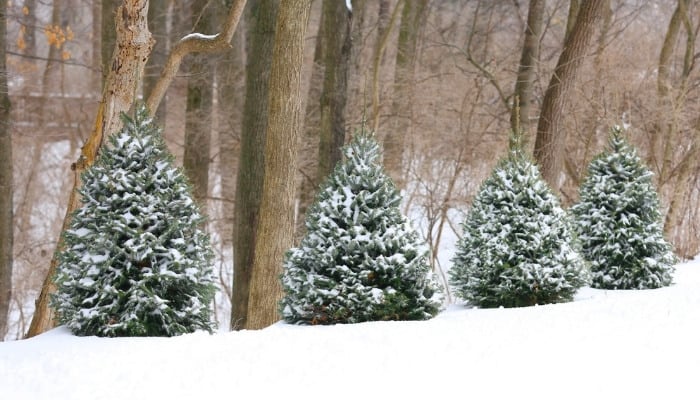As we are all aware, the majority of trees shed their leaves in autumn and winter, entering a dormant state until the arrival of spring.
However, many trees hold onto their leaves and stays full and vibrant all year long.
Which trees do not lose their leaves? Evergreen trees do not lose their leaves like deciduous trees do. They stay green for 12 months of the year so that they can continue photosynthesis all year. There are many types of evergreens, including pines, cypress, redwood, holly, live oaks, juniper, palms, spruce, cedar, and hemlock.
Evergreen trees are not temperamental. They tolerate a lot of environmental stimuli, which makes them the ideal landscaping tree.
Reading through the following will teach you how evergreen trees differ from deciduous and coniferous and why they stay green all year long.
You will also learn about the most popular types of evergreen trees and how they might improve your landscaping.
Understanding Evergreen Trees
Evergreen trees have one specific feature that sets them apart from any other tree.
What Are Evergreen Trees?
Evergreens are trees that keep their green foliage all year long. They keep some leaves while others fall off. Evergreen trees constantly grow new leaves, and they tolerate all kinds of weather.
Why Evergreen Trees Never Lose Their Leaves
Evergreens have a way of resisting the effects of bitter cold temperatures.
Their leaves and needles have a waxy substance covering them during the winter, which retains their chlorophyll and prevents dehydration. That is their form of hibernation.
Benefits of Evergreen Trees
Evergreen trees have many benefits. They provide shade and privacy.
You can plant a row of evergreens around your yard, and you will have a green wall that blocks out the sun and noisy neighbors.
Evergreens grow all year long, so there is no worrying about bare, dormant trees cluttering up your lawn.
They can withstand any soil type, including poor soil, and provide shelter for the birds and critters.
Deciduous vs. Coniferous vs. Evergreen
There are significant differences between evergreens and deciduous and coniferous trees.
Deciduous Trees
Deciduous trees change with the seasons. Their leaves are green during spring and summer, turn pretty colors in the autumn, and then fall off.
They are usually bare by winter. This is due to the lack of water after it freezes in the ground.
Deciduous trees are all over and come in all shapes and sizes.
Coniferous Trees
If you have seen trees with pine cones, those are coniferous trees. Not all coniferous trees have iconic pine cones. They can have fruit with a cone shape or cones that resemble berries.
Conifers differ from evergreens in two ways:
- Not all conifers are green
- All conifers have cones
Coniferous trees can add variety to a garden full of trees because of their cones, needles, and colors. They also come in different shapes and sizes.
Evergreen Tree
As you have already learned, evergreens stay green all the time. They do not lose all their leaves, and they do not have cones.
Popular Evergreen Trees for Landscaping
If you have landscape plans, consider evergreen trees. Here are examples of excellent trees to plant on your property.
1. Douglas Fir
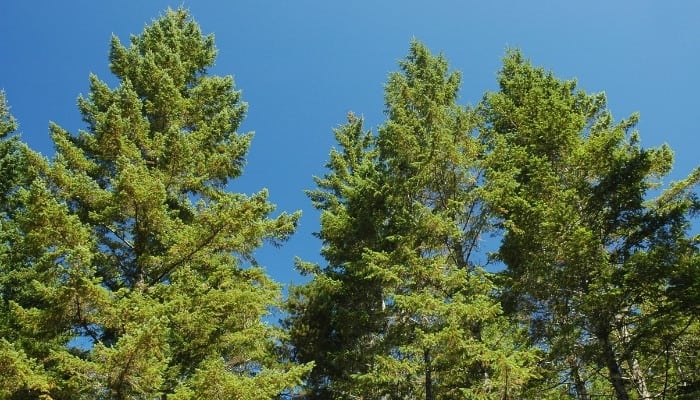
More of a loner, this evergreen tree makes a unique addition to your landscaping. Its needle-like, blue-green to yellow leaves grow individually from its branches.
Its appearance make it stand out from other trees, yet it blends in well too.
2. Cypress
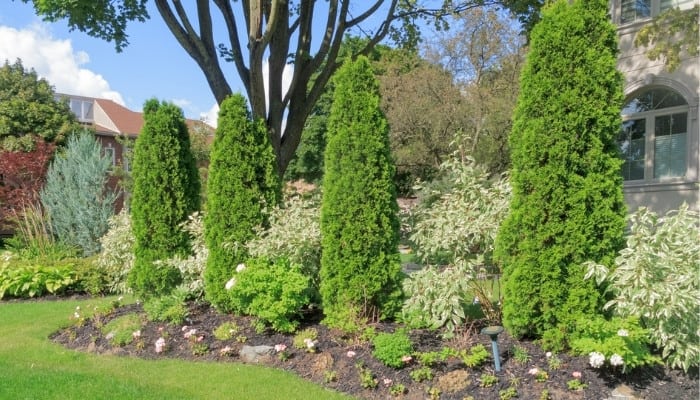
Cypress trees are perfect for landscaping because of their shape and colors.
They are known for their uniquely thin and pyramidal-shaped pine cones, and their leaves can vary from yellow-green to gray.
They must grow in areas with full or partial sunlight and should have moist soil at all times. Cypress trees are prone to diseases and need good preventative care.
3. Thuja Evergreen
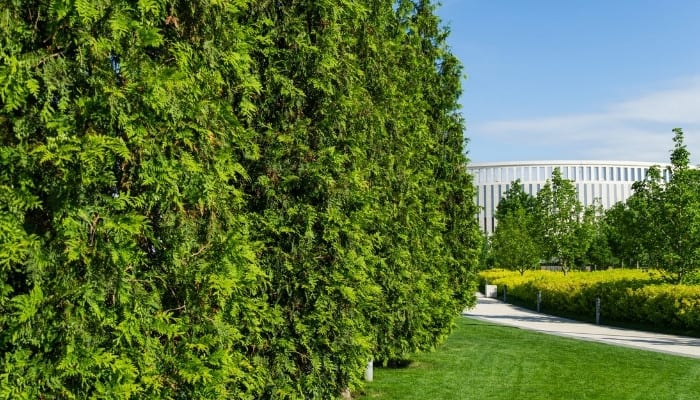
Thuja evergreens, sometimes known as arborvitaes, are trees that grow well in planters. They are slender trees that grow straight up to a maximum of 40 feet.
Some varieties can have fuller leaves and larger cones. Dwarf plants only grow about 10 feet.
4. Polar Gold Conifer
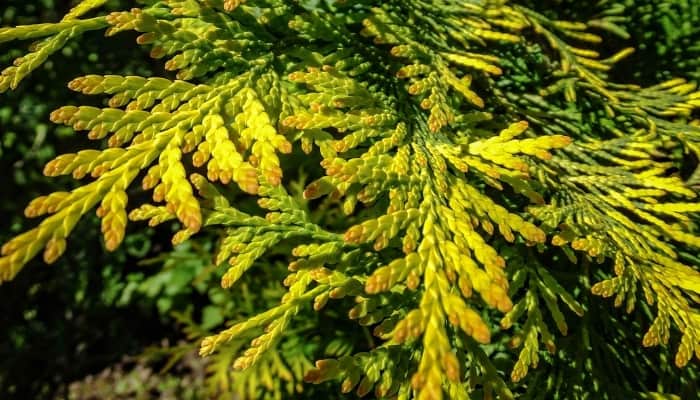
What makes the conifer an ideal landscaping tree is its adaptability to different types of soil and climates. It favors partial to full sun.
The narrow pyramid-like shape takes up less room, reduces the need for pruning, and compliments any yard, making it a perfect border tree.
Its leaves possess a golden-yellow color that glows in the sun.
5. Blue Arrow Juniper
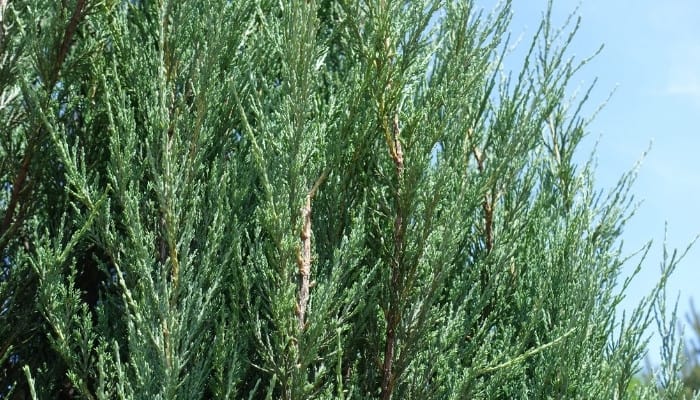
If you need a tree to line your sidewalk or entryway, the Blue Arrow Juniper may be the way to go. The narrow build (2 feet wide) is perfect for any pathway of your home or business.
The juniper has a unique silvery-blue color to it and grows bluish berries during the winter.
6. Cedar
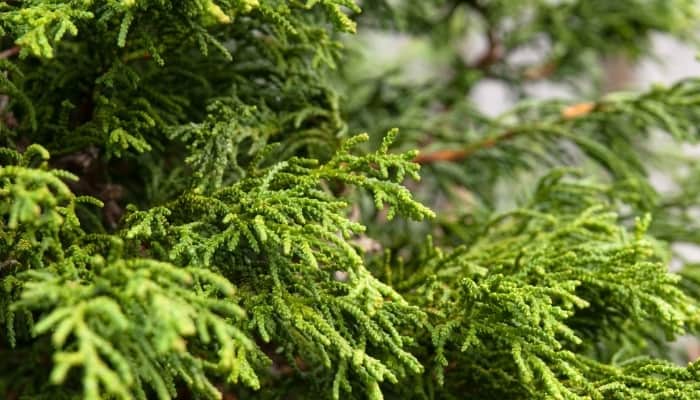
Cedar trees are a type of evergreen that grows at greater altitudes and prefers a lot of sun and soil that drains well.
You can identify a cedar tree by its bark, needles, and cones, which grow up instead of down.
If the bark is a scaly reddish-brown color and will easily peel, it is most likely a cedar tree. Their bluish-green needles might create a unique look to your lawn. There are many types of cedar trees.
Related Questions:
Do Evergreen Trees Produce Oxygen?
Yes, evergreens produce oxygen by taking in carbon dioxide and releasing oxygen, just as with other trees. This process is part of photosynthesis and helps to clean the air.
How Tall Are Evergreen Trees?
Most evergreen trees can grow 20-60 feet high, except for dwarf trees that only reach about 4 to 6 feet. Different types of trees, of course, vary in their height and life span.
Conclusion
Evergreens are different than most trees because of their year-round color and versatility. They are popular trees for landscaping purposes.
They keep their leaves all year round and are not bare in the winter as other trees are. They provide oxygen to the environment and cleanse the air. Consider an evergreen tree for your home or business.

